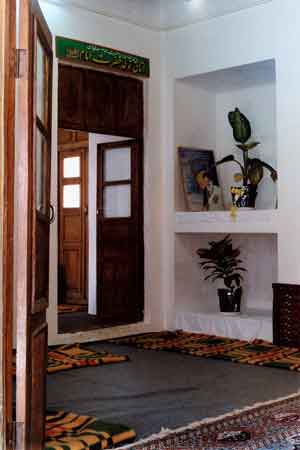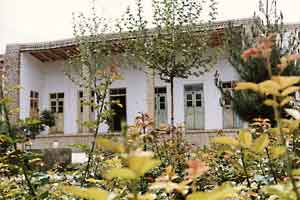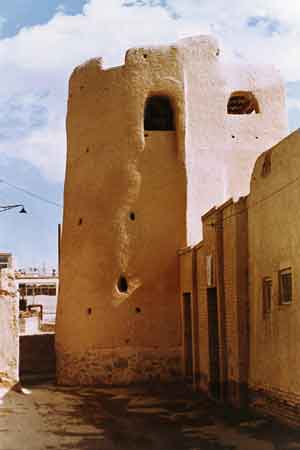Khomein is a town in the south-east of the central province of Iran. It is an old town, with some ninety surrounding villages. It goes back to more than 1500 years in history. Originally its name was Khomayhan which is a combination of Kho, which means 'good' and Mayhan, which means 'a place', i.e. a good place or a sacred place. This town and its surrounding villages were called Kamareh, too.
 The room where Imam Khomeini was born
The room where Imam Khomeini was bornHis Biography
On September the 24th 1901, which coincided with the anniversary of the birth of the Holy Prophet's (saw) only daughter Hadhrat Fatimah (saw), a boy was born in the household of the late Ayatollah Sayyid Mustafa Mousawi. The newborn was named Rouhullah, which means 'Spirit of Allah'.
In March 1902, some five months after Rouhullah's birth, his father Sayyid Mustafa was attacked and killed while travelling on the road between Khomein and the neighboring city of Arak. Then little Rouhullah was taken care of by his mother and his aunt Sahebeh.
At the age of 15, Rouhullah started to learn Islamic and Arabic grammar from his brother, Ayatollah Pasandideh. Although he was supposed to go to Isfahan for further studies on Islamic Culture, he ended up in Arak. Later, he moved to Qom to pursue his religious studies there.
His Home
 Khomein; Imam's childhood home which today has been turned into a museum
Khomein; Imam's childhood home which today has been turned into a museumImam's noble house is still a focus of great attention. It is admired much more as a symbol of people's resistance against oppression and discrimination imposed by unjust rulers. This becomes more tangible when the tower that stands in the yard's corner, makes one feel a spontaneous responsibility to harbor and support the downtrodden and the oppressed.
In 1835, Sayyid Ahmad bought a manor with an area of roughly 4,326 square meters in Khomein. It is a four-section manor located on the Sare-e-Pol region and has a unique architectural design. Unlike the traditional Iranian houses, it has four yards none of which is the central one. This building can be described as follows:
 The outer appearance of the Imam's residence
The outer appearance of the Imam's residence1.The Frontage:
It is a rather big piece of land, which is in front of the main gate and next to the road.
2.The Frontal Entrance:
It is a small section next to the main door. The door contains two folds, each made of thick timbers horizontally nailed to the threshold.
3.The Vestibule:
It is a small octagonal room next to the frontal entrance or in fact a part of it that leads to a narrow passageway.
4.The Corridor:
It is a narrow dark passageway that indeed prevents strangers' unexpected entrances into the interior part of the manor.
5.The Yards:
There are four paved yards each one with a small flower-bed and a pond. The four are:
a.The interior yard, which belonged to Sayyid Mustafa (Imam's father), and used to be his private arae. It was later handed down to Ayatollah Pasandideh, who was the Imam's elder brother.
b.The exterior yard which was used as Sayyid Mustafa's room for teaching and holding religious sessions, and also for entertaining quests.
c.The yard where the Imam was born and which had a cellar
d.The yard which the Imam inherited from his late father.
6.The Rooms:
They are scattered around the four yards, some of which are intended for the winter and others for the summer.
7.The Cellar:
It is under the main hall with four straight corridors that join the two yards from two sides. The continual draft passing through these corridors along with the thick ceiling creates a delicately cool place to keep food in and a pleasant resting-place in the summer.
8.Tower:
At the north of the manor, there exists a three stories tower. Usually the lower stories were used as the resting place of the guards. The height of tower is about 11 meters and all the area of the city could be seen from the top of the tower. The tower is considered both as an architectural feature of the manor and a defensive barrier against enemies. There exist other places such as the stables, warehouses and kitchen which are among the functional atmospheres of the manor. Presently, as a historical-cultural site, this complex is visited all year round by visitors, researchers and admirers of Imam Khomeini.